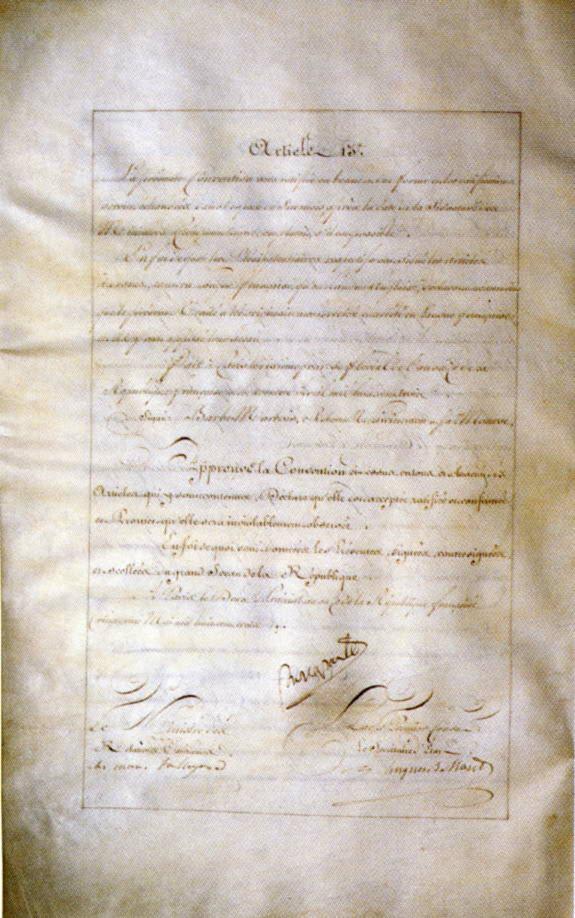The
Louisiana Purchase Treaty |

| With no idea of the extent of their
acquisitions—one of the greatest bargains in history—Robert Livingston
and James Monroe signed the Louisiana Purchase Treaty in Paris. The
$ 15 million price tag was well worth it. Congress had authorized
them to pay France up to $10 million for the port of New Orleans and the
Floridas. Planning further warfare in Europe, Napoleon needed cash
and so offered to sell the entire Louisiana territory'—an area larger than
Great Britain, France, Germany, Italy, Spain, and Portugal combined—and
the American negotiators swiftly agreed. Under the terms of this
treaty, concluded on April 30, 1803, the United States purchased 828,000
square miles of land west of the Mississippi River for roughly four cents
an acre. The United States doubled its size, reaching westward toward
the Pacific Ocean.
President Thomas Jefferson was somewhat unsure he had the authority to add such a vast new territory to the existing republic, but his momentous decision would further his vision of an "empire for liberty" that would stretch from coast to coast. |

| TREATY BETWEEN THE UNITED
STATES OF AMERICA AND THE FRENCH REPUBLIC
The President of the United States of America and the First Consul of the French Republic in the name of the French People desiring to remove all Source of misunderstanding relative to objects of discussion mentioned in the Second and fifth articles of the Convention of the 8th Vendé miaire an 9/30 September 1800 relative to the rights claimed by the United States in virtue of the Treaty concluded at Madrid the 27 of October 1795, between His Catholic Majesty & the Said United States, & willing to Strengthen the union and friendship which at the time of the Said Convention was happily reestablished between the two nations have respectively named their Plenipotentiaries to wit The President of the United States, by and with the advice and consent of the Senate of the Said States; Robert R. Livingston Minister Plenipotentiary of the United States and James Monroe Minister Plenipotentiary and Envoy extraordinary of the Said States near the Government of the French Republic; And the First Consul in the name of the French people, Citizen Francis Barbe Marbois Minister of the public treasury who after having respectively exchanged their full powers have agreed to the following Articles. Article I Whereas by the Article the third
of the Treaty concluded at St Ildefonso the 9th Vende miaire an 9/1 st
October 1800 between the First Consul of the French Republic and his Catholic
Majesty it was agreed as follows.
Article II In the cession made by the preceeding article are included the adjacent Islands belonging to Louisiana all public lots and Squares, vacant lands and all public buildings, fortifications, barracks and other edifices which are not private property. —The Archives, papers & documents relative to the domain and Sovereignty of Louisiana and its dependances will be left in the possession of the Commissaries of the United States, and copies will be afterwards given in due form to the Magistrates and Municipal officers of such of the said papers and documents as may be necessary to them. Article III The inhabitants of the ceded territory
shall be incorporated in the Union of the United States and admitted as
soon as possible according to the principles of the federal Constitution
to the enjoyment of all these rights, advantages and immunities of citizens
of the United States, and in the mean time they shall be maintained and
protected in the free enjoyment of their liberty, property and the Religion
which they profess.
DONE AT PARIS THE TENTH DAY OF FLOREAL IN THE ELEVENTH YEAR OF THE FRENCH REPUBLIC; AND THE 30TH OF APRIL 1803. Robt R Livingston
[SEAL]
|

In addition to this Treaty of Cession, the Louisiana Purchase Agreement comprises two conventions specifying the financial aspects of the agreement, one calling for the payment of 60 million francs ($11,250,000), the other for claims U.S. citizens had made against France for 20 million francs ($3,750,000).
A CONVENTION BETWEEN THE UNITED STATES OF AMERICA AND THE FRENCH REPUBLIC
Article I
The Government of the United States engages to pay to the French Government in the manner Specified in the following article the sum of Sixty millions of francs independant of the Sum which Shall be fixed by another Convention for the payment of the debts due by France to citizens of the United States.
...DONE AT PARIS THE TENTH OF FLOREAL ELEVENTH YEAR OF THE FRENCH REPUBLIC 30THAPRIL 1803.
Robt R Livingston [SEAL]
Jas. Monroe [SEAL]
Barbe Marbois [SEAL]

The last page of the second convention settles the claims of American citizens against France. It was signed with a flourish by "Bonaparte"—Napoleon Bonaparte, emperor of France.
